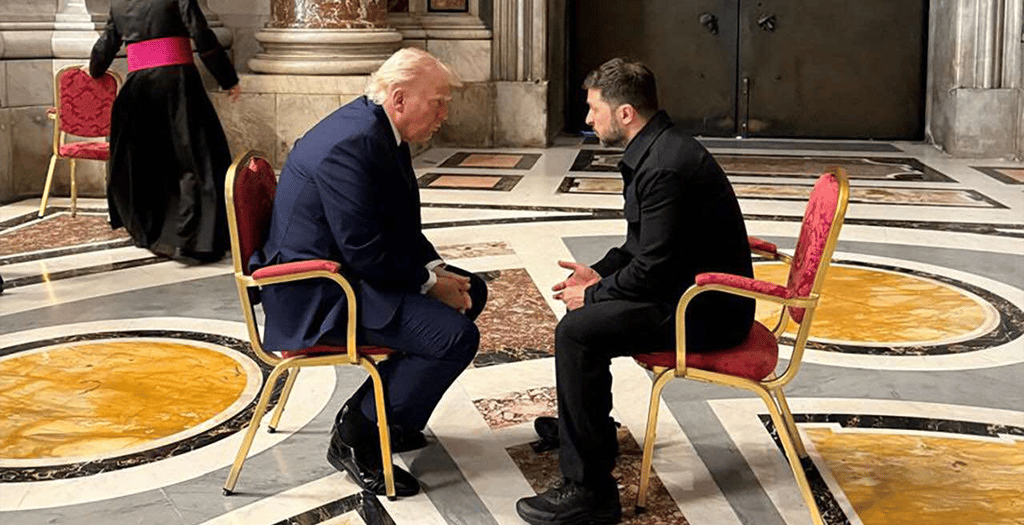A Moment for Peace: Trump and Zelensky’s Vatican Meeting Amid Ukraine’s Turmoil
4/27/20254 min read


A Moment for Peace: Trump and Zelensky’s Vatican Meeting Amid Ukraine’s Turmoil
On April 26, 2025, as the world mourned the passing of Pope Francis, an unexpected diplomatic moment unfolded in the hallowed halls of St. Peter’s Basilica. U.S. President Donald Trump and Ukrainian President Volodymyr Zelensky met one-on-one for a 15-minute discussion described by the White House as “very productive.” Against the backdrop of Russia’s escalating territorial gains in Ukraine, this meeting carried the weight of hope for a war-weary world. But what did this brief encounter achieve, and could it mark a turning point in the quest for peace in Ukraine?
A Symbolic Setting for Diplomacy
The setting couldn’t have been more poignant. St. Peter’s Basilica, steeped in centuries of spiritual and historical significance, hosted this high-stakes conversation just before the funeral Mass for Pope Francis, a pontiff who tirelessly advocated for peace. Photographs released by Ukraine captured Trump and Zelensky leaning toward each other, seated on simple chairs, their faces intense with focus. The image, set against a mosaic of Jesus’ baptism, evoked a sense of gravity and possibility. Ukrainian Foreign Minister Andrii Sybiha called it a “historic meeting,” while Zelensky himself described it as “very symbolic” with the “potential to become historic” if results follow.
The meeting wasn’t entirely impromptu. British Prime Minister Keir Starmer and French President Emmanuel Macron, who have championed a “coalition of the willing” to enforce a potential peace deal, briefly joined the leaders before the one-on-one began. Their presence underscored the international stakes, as Europe and the U.S. grapple with how to end a conflict that has claimed countless lives and reshaped global alliances.
The Context: Russia’s Advances and Trump’s Doubts
The timing of the meeting was critical. Russia’s recent missile strikes on Kyiv and claims of significant territorial gains in Ukraine painted a grim picture. Just days before, Trump had expressed optimism that Russia and Ukraine were “very close to a deal.” Yet, after the Vatican meeting, he voiced skepticism about Vladimir Putin’s commitment to peace, accusing the Russian leader of “tapping me along” and criticizing missile attacks on civilian areas. This shift in tone suggests the meeting with Zelensky may have recalibrated Trump’s perspective, at least temporarily.
Zelensky, for his part, reiterated his call for a “full and unconditional ceasefire” as a prerequisite for any peace talks. He has consistently rejected proposals that involve ceding territory, particularly Crimea, which Russia annexed in 2014. Trump, however, has previously pushed for Ukraine to make territorial concessions to secure a deal, a stance that has strained their relationship. Their February 2025 Oval Office meeting devolved into a public spat, with Trump and Vice President JD Vance accusing Zelensky of ingratitude for U.S. aid. The Vatican meeting, by contrast, appeared calmer and more constructive, perhaps aided by the solemn atmosphere.
What Was Achieved?
Concrete outcomes remain elusive. The White House offered little detail beyond calling the discussion “very productive,” while Zelensky expressed hope for “joint results” without specifying what those might be. The meeting’s brevity—15 minutes—suggests it was more about setting the stage than finalizing agreements. Still, its symbolism can’t be overstated. The fact that Trump and Zelensky, whose prior interactions were marked by tension, sat down face-to-face in such a setting signals a willingness to engage.
The presence of Starmer and Macron hints at broader international coordination. The UK and France have floated plans for a peacekeeping force to monitor any ceasefire, with the U.S. reportedly offering security guarantees. These ideas, however, hinge on Russia’s cooperation, which remains uncertain given Putin’s recent actions and rhetoric. The Kremlin claimed Putin is open to talks “without preconditions,” but Zelensky’s insistence on a ceasefire first creates a diplomatic stalemate.
Why It Matters
This meeting wasn’t just about Ukraine; it was a microcosm of global power dynamics. Trump’s push for a swift resolution reflects his desire to project strength and deliver on campaign promises to end foreign conflicts. Zelensky, meanwhile, is fighting to preserve Ukraine’s sovereignty while navigating pressure from allies to compromise. The Vatican setting, steeped in the legacy of Pope Francis’s peace advocacy, added a moral dimension, reminding leaders of the human cost of inaction.
For ordinary Ukrainians, the stakes are existential. Russian missile strikes on civilian areas, as Trump noted, underscore the urgency of a ceasefire. Yet, any deal that cedes territory risks betraying the sacrifices of Ukraine’s people. The applause that greeted Zelensky’s arrival at the funeral—a rare breach of Vatican protocol—reflected global solidarity with his cause.
Looking Ahead
The Vatican meeting may not have produced immediate breakthroughs, but it kept the door open for dialogue. Trump’s frustration with Putin suggests he may pivot to tougher measures, such as sanctions, which enjoy bipartisan support in the U.S. Zelensky’s diplomatic blitz, including follow-up talks with Starmer and Macron, shows he’s working to maintain international backing. Whether these efforts translate into peace depends on whether both sides can bridge the gap between ceasefire demands and territorial realities.
As the world watches, the image of two leaders in St. Peter’s Basilica lingers—a fleeting moment that could either fade into history or spark the first steps toward peace.
Thought-Provoking Questions for Readers:
1. Can Trump and Zelensky overcome their past tensions to broker a lasting peace, or will their differing priorities derail progress?
2. Should Ukraine consider territorial concessions to end the war, or is Zelensky right to hold firm on a full ceasefire first?
3. How much influence can symbolic settings like the Vatican have on hard-nosed diplomacy in a time of war?
Photo Credit:GettyImage
hello@boncopia.com
+13286036419
© 2025. All rights reserved.